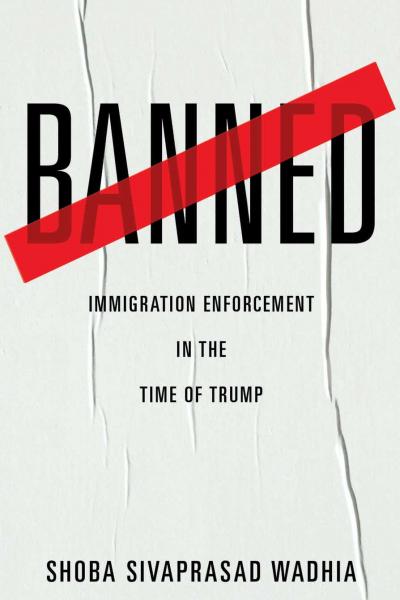Guest post by Chris Levesque. Chris is a PhD Candidate in Sociology at the University of Minnesota – Twin Cities and Population Trainee at the Minnesota Population Center. His research interests are U.S. immigration, demography, and procedural fairness in immigration court. He is on Twitter @krislevrek.
Review of Banned: Immigration Enforcement in the Time of Trump by Shoba Sivaprasad Wadhia (New York University Press, 2019)

Discretion forms the backbone of this book’s argument. To highlight one example, Wadhia shows how Trump’s administrative actions such as imposing case completion quotas for judges unfairly targeted non-citizens and put the U.S. immigration court system on the “brink of collapse,” as suggested by a recent American Bar Association (2019) report. Seamlessly, Banned sits in dialogue with Asad (2019) and Ryo’s (2016) scholarly work on judicial decision-making, Kanstroom’s (1997) work on the institutionalization of discretion within government agencies, and FitzGerald’s (2019) research on immigration enforcement and the surveillance state.
Banned does more than simply parse out the ever-changing litany of Trump’s immigration policies. It highlights how structures of immigration law cut across administrations, particularly since DHS’s formation in 2002. Delving into topics ranging from the Muslim ban to asylum policy to Deferred Action for Childhood Arrivals (DACA), Wadhia shows how much latitude is given to DHS and the Executive branch to make limited, yet consequential changes to the U.S. immigration system. Further, it describes what policy advocates can do to reverse those changes that negatively impact immigrants’ lives.
The book takes care to describe each of Trump's three Muslim bans in Chapter 2, as well as how the courts and public advocates have challenged Trump’s executive orders to enforce these bans. At the time of the book’s publication, Trump’s executive order effectively banned foreign nationals from eight countries. While not all countries are majority Muslim, Wadhia is clear about the original intent of Trump’s first executive order: to institutionalize Islamophobia and to mandate the possibility of excluding more Muslim and non-Muslim immigrants in the future. The Trump administration expanded the travel ban on January 31st of this year to restrict immigration from a new set of countries to prevent those with “terrorist connections” or “criminal ties” from entering the U.S.
Chapters 3 and 4 cover the criminalization of non-citizens living within the U.S., including those with lawful permanent resident status, those on DACA and Temporary Protected Status, and those with refugee status. For example, judicial discretion once protected legal resident visa holders with final removal orders; those same protections have now been ripped away. Prosecutorial discretion used to provide safeguards for individuals considered low priorities for enforcement with a temporary form of protection known as deferred action (DACA, for example); DHS no longer prioritized those protections under Trump.
Based on her book’s interviews, Wadhia discusses the real possibility that more non-citizens living in the U.S. (or people who merely appear to be “foreign”) will be targeted for removal without a day in court. In pursuing a policy of “zero tolerance” for illegal border crossings, the administration sought to not only deter illegal immigration to the U.S. but also to create fear among immigrants already living in the U.S. that they may be next. In this sense, “everyone is a priority,” as Wadhia suggests (p. 43), and the fear of being targeted affects not only non-citizens’ lives, but also those of their children, family members, and friends.
With that in mind, it is concerning that the general public knows very little about the country’s immigration enforcement procedures. During the COVID-19 pandemic, travel bans across the world have expanded even further – and Banned shows how bans in the U.S. and elsewhere may be sustained into the future. Xenophobia can also spread like a virus, particularly towards Asian-Americans in the U.S. case, making it all the more important to think about how fear has and will continue to shape immigration policy in the weeks, months, and years ahead.
This book should not only resonate with migration scholars, lawyers, and policymakers, but also with a broader public audience who feel anxious and emboldened in these exponentially terrifying times. In a recent talk, Wadhia said that the way we expand public knowledge is to think about discretion with a capital “D,” signaling that much broader structural immigration reform is needed to ensure that discretion can protect immigrants rather than disproportionately punish them. What Banned does so well is give the general public the tools and context necessary to understand emerging trends, such as recent and ongoing travel ban expansions. Wadhia joins other legal scholars and migration researchers in calling for more advocacy on the ground — advocacy that jumpstarted with an outpouring of responses after the first Muslim ban but must continue into the future with a new administration.
Any comments about this post? Get in touch with us! Send us an email, or post a comment here or on Facebook. You can also tweet us.
__________
How to cite this blog post (Harvard style)
Levesque, C. (2021). Book Review: Banned: Immigration Enforcement in the Time of Trump. Available at: https://www.law.ox.ac.uk/research-subject-groups/centre-criminology/centreborder-criminologies/blog/2021/03/book-review-0 [date]
Share:








